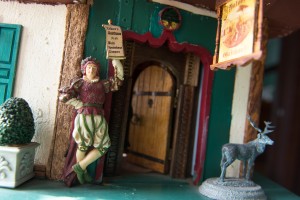
Evans, a UCLA alumnus who worked various positions in the UCLA International Institute for 19 years, devoted 15 years to crafting a miniature inn – his reinterpretation of the 1368 restaurant located in the town of Bacharach, Germany.
His five-story miniature of the Altes Haus, which means “old house” in German, was completed in 2004 after years of self-study and research on German Renaissance architecture, Evans said.
The inn, which is almost as tall as the creator himself, consists of 14 rooms, 32 working electric lightsand numerous staircases and hallways. It boasts a stately, sturdy exterior that contrasts with the intricate interior, decorated with Italianate murals and furniture worn with age.
“When I talk to people who build miniatures, they say they want an environment they control – something that’s sort of their little world. And I think that’s probably true in my case,” Evans said.
He got the idea in the late 1980s, when he attended miniature exhibitions that showcased children’s dollhouses and more realistic, true-to-life structures.
Modern, contemporary styles did not appeal to Evans because he said he finds old architectural styles to be more “romantic.”
“The architecture and objects in the house have more artistry in them and are more unique because they were made by an individual,” Evans said. “They have a value that our modern society doesn’t have anymore.”
Victorian and Tudor-style houses were popular among other miniaturists at the time, but he decided to deviate from the standard by focusing on a rarely pursued style in dollhouse crafting: German Renaissance.
“My whole life I have been an outsider,” Evans said. “I have been afraid of convention and looking for some unique place in the world. This sort of fits that pattern.”
Evans said his parents were followers of spiritualism, a religious faith that believes in communication with the dead.
“It made me not fit in that well with my schoolmates,” he said. “I always thought the most interesting things are things that you have to hunt for, things that were unusual. I was like that about politics and I was like that with the dollhouse.”
As a child, Evans said part of growing up was about learning to develop patience and attention to detail – the skills he said were necessary to build his dollhouse.
“I once tried to build a big model airplane. I did the first few steps of it and never got anywhere (near) finishing it,” Evans said. “Today, it would be easier to do that, but back then I couldn’t do it.”
Evans said he developed patience and attention to detail in his adulthood, when he began working as writing staff and later a managing editor of Intercontinental Press, which was a weekly news magazine of an international socialist organization. He was a member of the Socialist Workers Party and an advocate of the ideas of Leon Trotsky, a Russian Marxist revolutionary.
The mental skills that he developed from his job at the magazine helped him not only with his job as a website and publications manager at the UCLA International Institute, but also with his dollhouse project, he said.
Evans constructed the exterior of the house solely based on the black-and-white image he found in the library. The interior, however, is Evans’ brainchild.
Evans said he could not find images of the interior of the Altes Haus, so he resorted to a book with photos of German Renaissance-themed rooms, looking for definitive style elements, such as the high plate rails, ceramic stoves and ceiling murals.
Once he was finished with the blueprint, using the images as his reference point, he proceeded to construct the building – floor after floor – in the shed behind his house during weekends and holidays while he was working at UCLA.
“He did it very seldom, one or two weeks out of the year,” said Jennifer Charnofsky, his wife. “He was very focused. He was having a really good time.”
Artificial aging, scale carpentry and other practical skills that Evans needed to construct the dollhouse were gleaned from reading books and magazines. He gained the confidence to tackle complex projects after working at various jobs that required physical labor.
He said he remembers learning how to take apart a railroad engine made up of 100 different parts while working at an electrical motor shop decades ago. Taking on such a complex and time-consuming task gave Evans the skills that he later used when making his dollhouse.
“There’s always some risk with something this ambitious,” Evans said. “But part of that experience (of) working in the physical kind of jobs where you (have) to think through a complicated piece of machinery gives you the confidence to do this.”
Richard Gunde, a former assistant director of the UCLA Center for Chinese Studies and longtime friend of Evans, said he remembers the time when he first saw Evans’ finished dollhouse.
“I was really impressed because I’ve made things out of wood myself, so I know how much work and planning it took,” Gunde said. “The other aspect (I was impressed by) was his effort to capture history in the dollhouse. It’s not a toy.”
Although Evans currently doesn’t have any plans to make a second dollhouse, he said he has made smaller dioramas that take less time and effort to make.
These days, he spends his time writing books about national political issues.
Evans said he is now more focused on issues that may unravel in the future, as opposed to architectural styles of the past.

I’ve been trying to reach Nader with no luck. Writer’s email address is incorrect. Does anyone have his contact info?